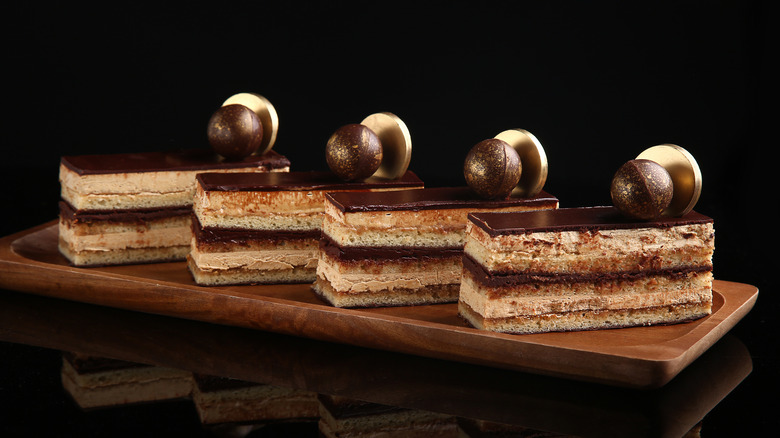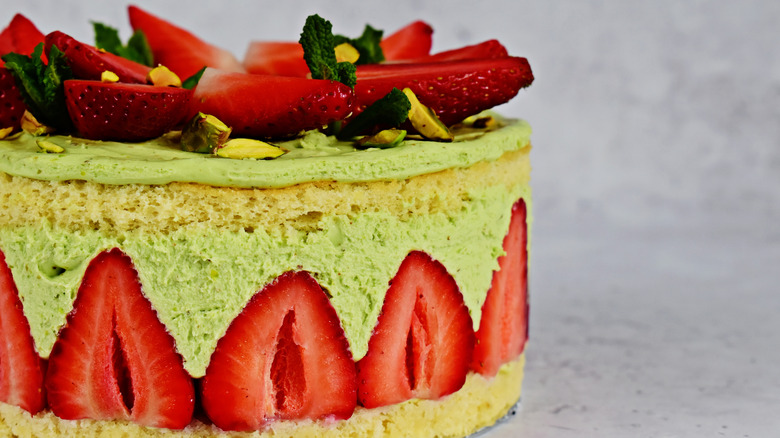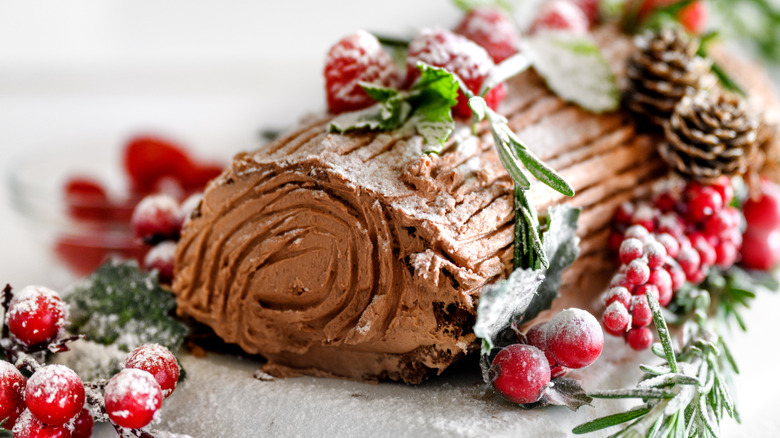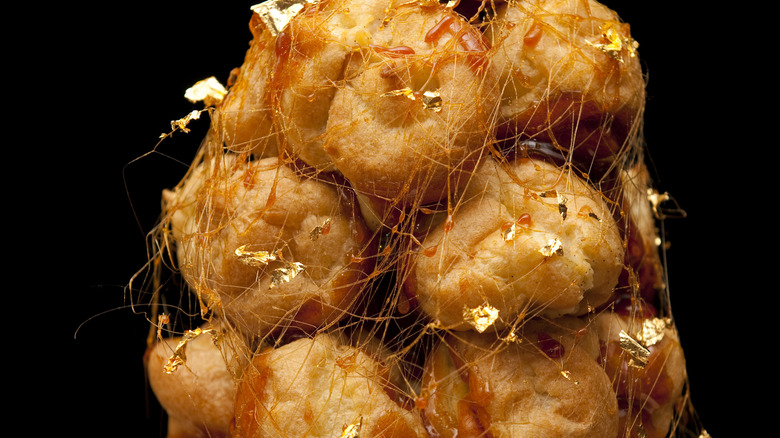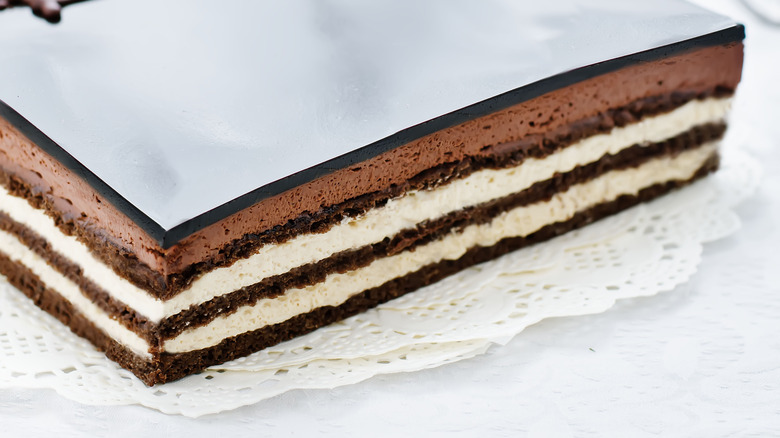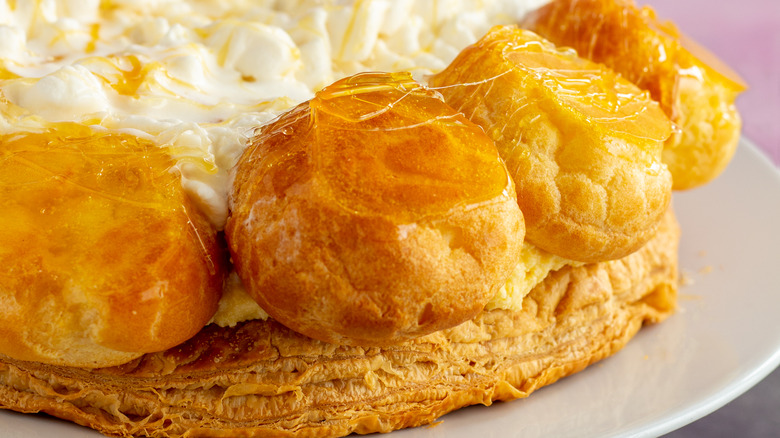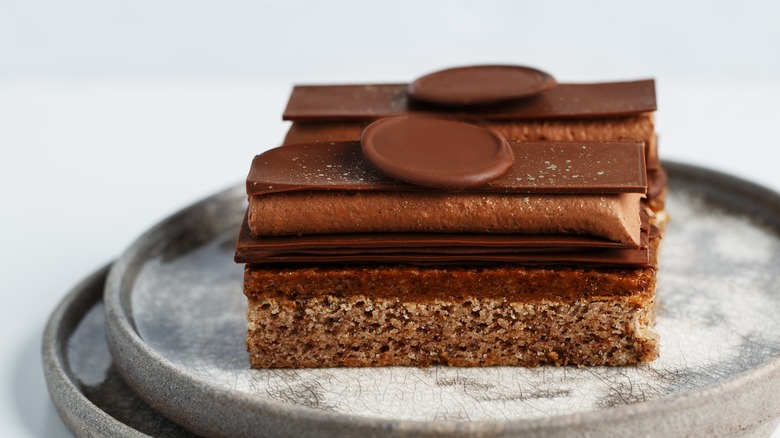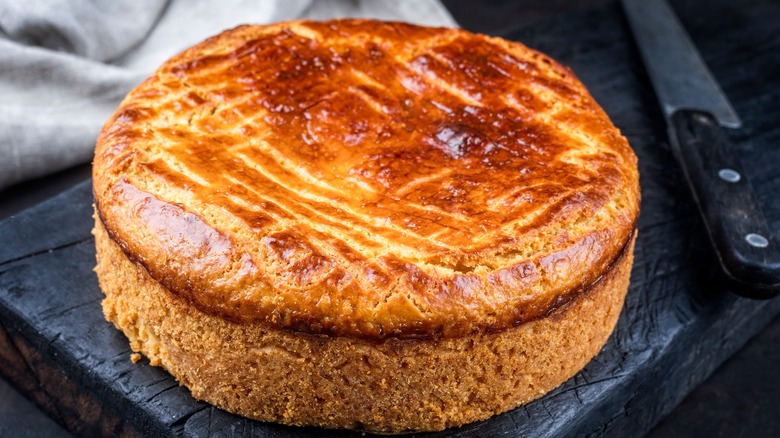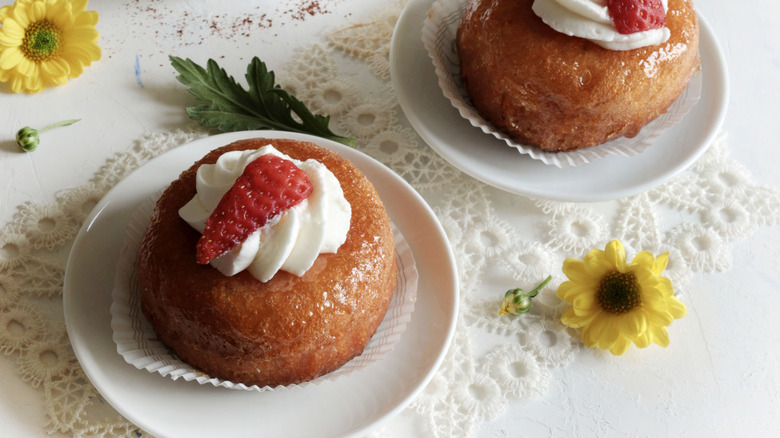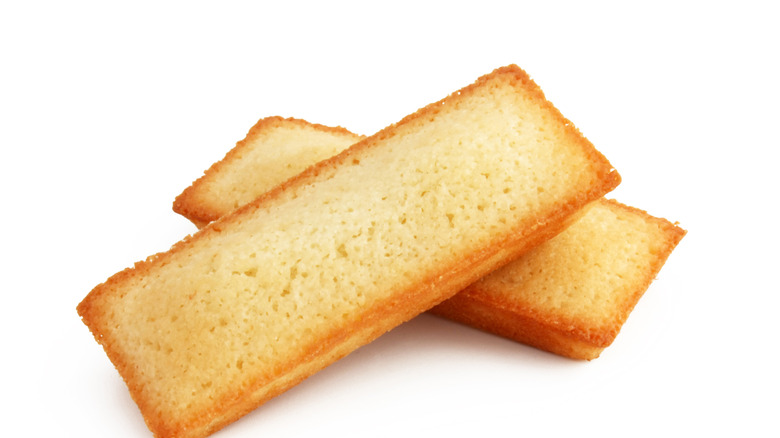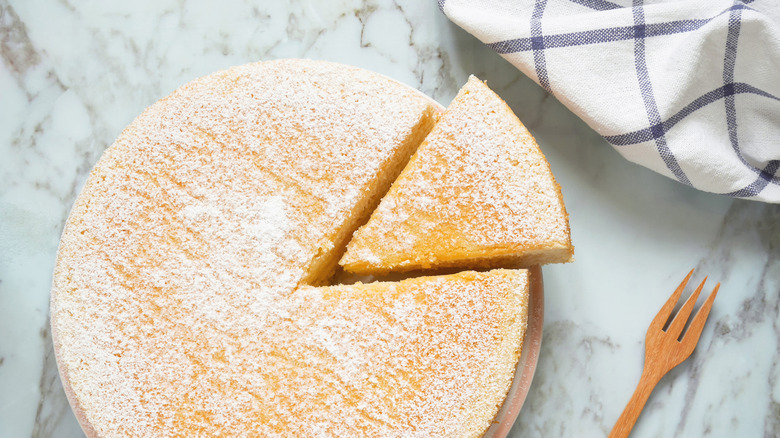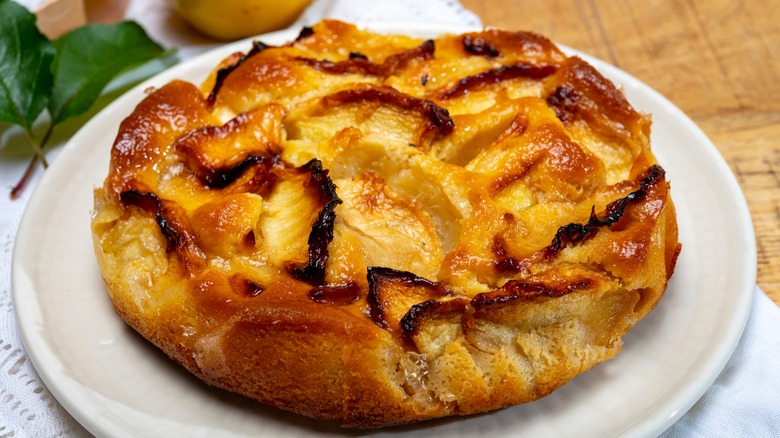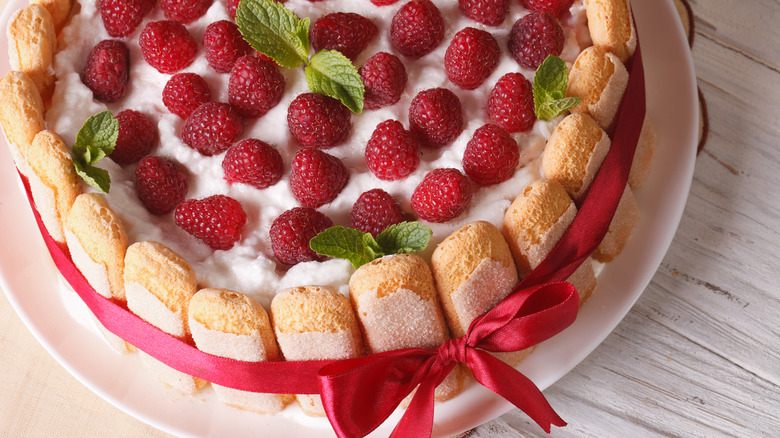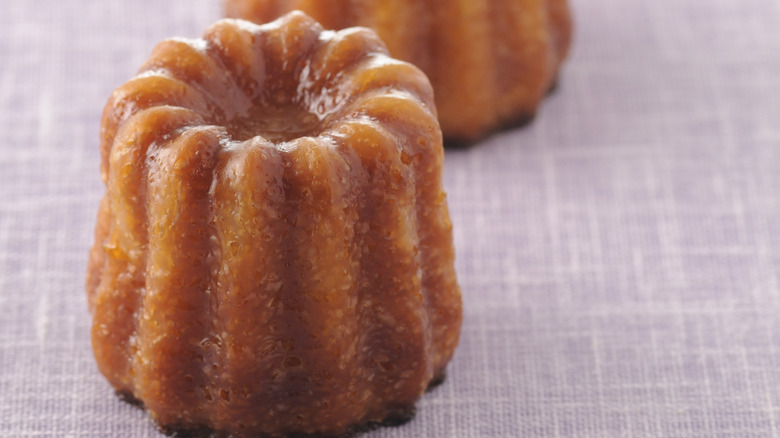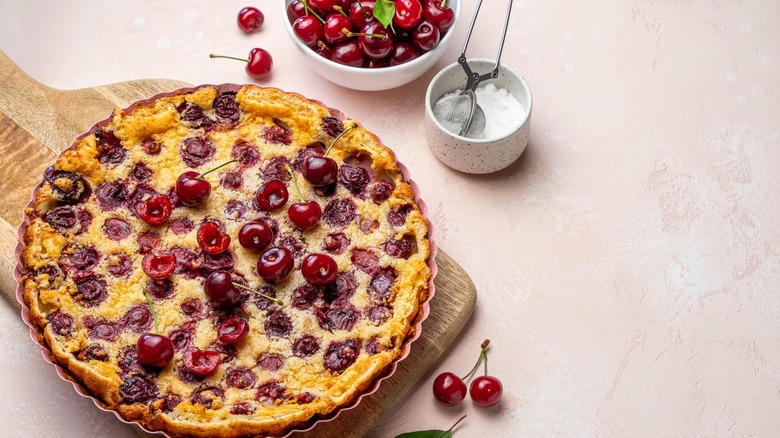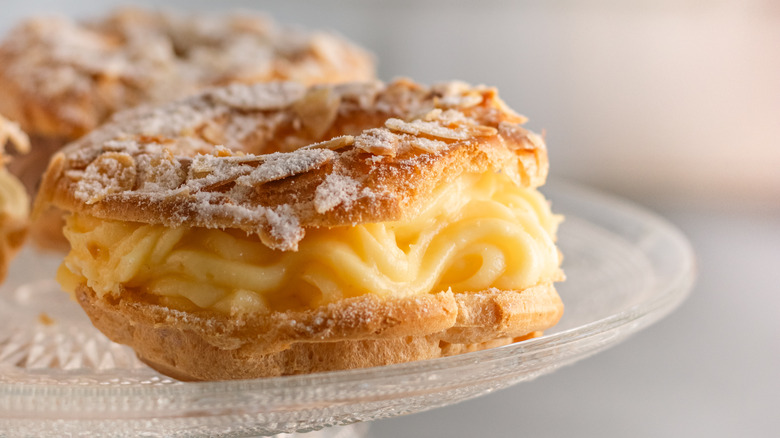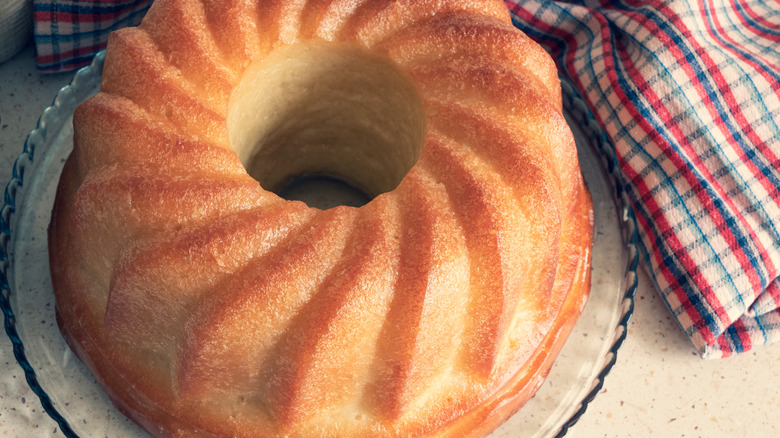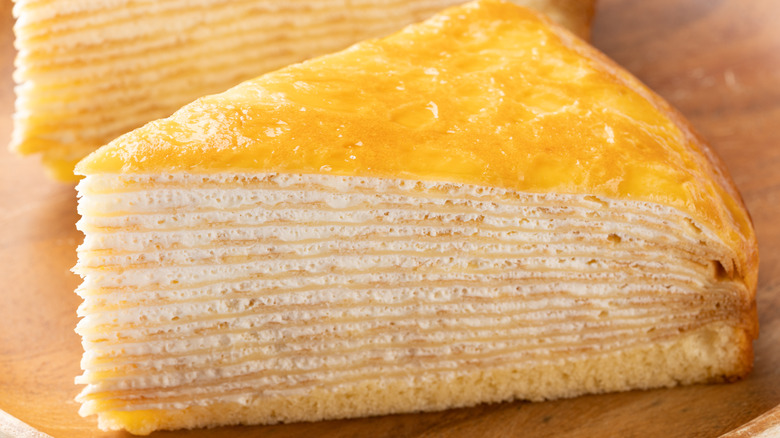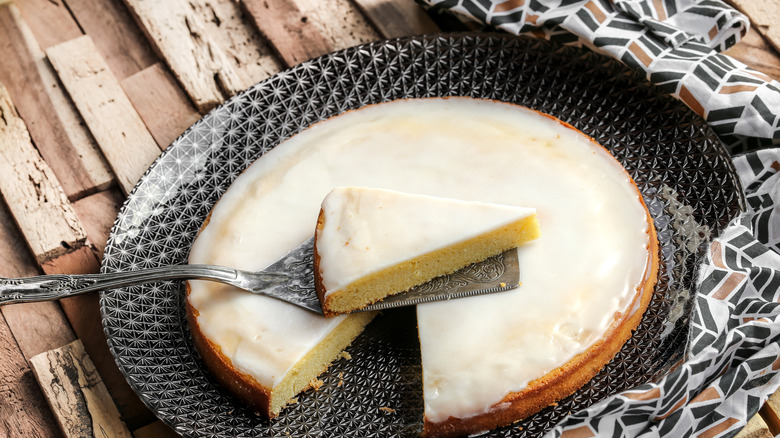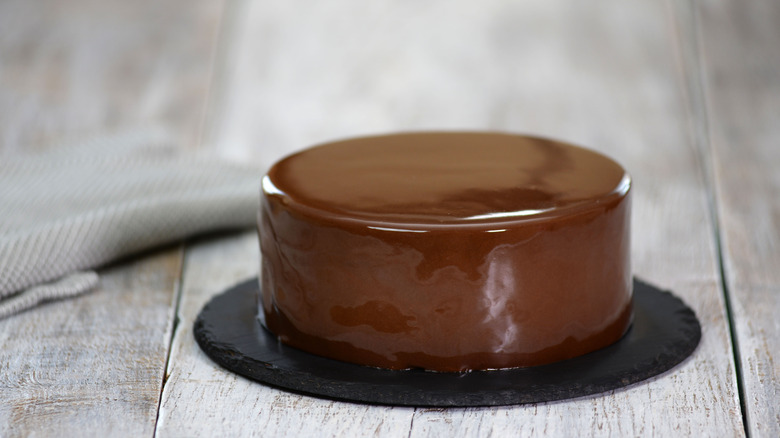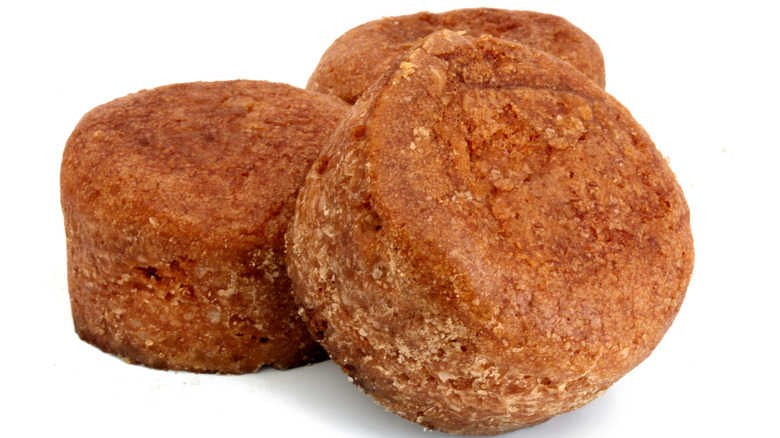20 French Cakes You Need To Try At Least Once
The French are masters of pastry, so it's no surprise that their cakes are some of the very best in the world. When it comes to dessert, French cuisine is the gold standard of precision and aesthetics. Classic French cakes are ingredient-forward, celebrating the flavors of anything from chocolate to fruit without masking them with sugar. France is steeped in the tradition of cuisine, and French chefs take their pastries (and cakes) very seriously. The resulting recipes have been passed down over generations and perfected.
Some of these cakes are humble, everyday affairs: The classic French yogurt cake, which many a French cook would know by heart, relies on a jar of yogurt as the unit of measurement. But most of them are technical, requiring an understanding of some of the more difficult skills in pastry, like achieving the perfect temperature of caramel or a knowledge of lamination to make flaky homemade puff pastry.
As a veteran baker and longtime writer for King Arthur Baking Company, I've spent countless hours discussing the merits, architecture, and technique of French pastry and cakes. Here, I'll dive into 20 of the very best French cakes and what makes them so distinctive.
1. Frasier
Two layers of delicate, fluffy genoise cake sandwich a luscious vanilla mousseline filling. Genoise is a sponge cake that is enriched with egg yolks and butter. It has an airy, delicate crumb, just like a classic sponge cake, but boasts a richer flavor and beautiful yellow color.
Mousseline, or créme mousseline, is simply pastry cream with butter beaten in after it cools. The result is as rich and flavorful as pastry cream with a luscious, thick texture closer to buttercream. Mousseline is easy to pipe and spread and holds its shape well. Here, it serves a purpose of flavor and architecture. Nestled into the mousseline are sliced strawberries carefully placed around the outside of the cake, which gives it its iconic appearance.
2. Bûche de Noël
What holiday dessert tableau is complete without a bûche de Noël, or Yule log, as a centerpiece? This jelly-roll style cake is adorned with sugared decorations to resemble a real log topped with holly leaves and miniature mushrooms. The history of the cake isn't very long, but the inspiration for it dates back centuries. In Europe, a Yule log (a large, heavy log) would be lit on Christmas Eve and rekindled each day until Twelfth Night.
The Yule log was central to the holiday festivities, and the Yule log cake is a celebration of that tradition. While bakers make all varieties of bûche de Noël cakes, varying the fillings and flavorings, the traditional form is a chocolate or vanilla sponge cake (or Swiss roll) filled and frosted with chocolate buttercream. Typical flavor enhancements echo the season: chestnuts, rum, and eggnog.
3. Croquembouche
Traditionally prepared as a wedding cake in France, a towering croquembouche is more of an assemblage of pastry. Semantics aside, it's a wildly impressive labor of love. A tower of profiteroles filled with pastry cream is cemented in place by golden shards of caramel. While pastry chefs and bakers worldwide like to give this stunning dessert their flavor spins, a croquembouche is typically made with vanilla pastry cream. The name means "crunch in the mouth" in French, as each bite of a profiterole crunches with the caramel coating.
Croquembouche is a notoriously difficult dessert to master, since the caramel needs to be the perfect consistency and texture in order to cement the profiteroles together without the tower sagging or leaning, but not be too hard or it becomes difficult to eat. When making caramel, chefs have to work quickly to build the tower before the caramel hardens.
4. Opera Cake
The history of this intricate, iconic cake is a contested one. Two different Parisian bakeries claim to have invented it: Maison Lenôtre in the 1960s and Maison Dalloyau in 1955, but no definitive account exists. Layers of almond sponge cake soaked in coffee syrup alternate with coffee buttercream and chocolate ganache, all enrobed in glistening chocolate. It gets its name from its architectural layers, which are said to resemble an opera house.
5. Gâteau St. Honoré
Named for the patron saint of pastries, Saint Honoré, this cake is a master class in French pastry as it combines many different elements: choux pastry, puff pastry, chantilly cream, and caramel. It's a dessert to test even the most seasoned pastry chef's skills, as every component requires technical ability to get just right, and then there's the laborious task of assembly.
Bakers interpret this particular cake in a variety of ways, adapting the filling to new flavors and changing the shape from round to square and beyond. But all versions of the cake include layers of crackly, flaky puff pastry filled with some type of pastry cream (either straight pastry cream or crème chiboust, which is pastry cream lightened with meringue) topped with cream puffs (small balls of filled choux pastry), all cemented into place with caramel.
6. Marjolaine
This layered cake puts a basic American layer cake to shame. All marjolaine cakes rely on dacquoise — a nutty, typically flourless almond cake — as their base, which is covered in layers of praline buttercream and swathed in rich chocolate ganache. It is a study in contrasts from creamy and crunchy to light and rich. The dacquoise cake itself is moist and almost chewy.
It's a close cousin to the base of a macaron, as both are made with ground nuts (almonds or sometimes hazelnuts) and whipped egg whites to give the pastry body and structure. When combined with the buttercream, the sponge layers soften slightly, creating a dense and rich mouthful of cake.
7. Gâteau Basque
Filled with black cherry jam or pastry cream, this cake from the Basque region features a thick dough, closer in style to a pâte sucrée than a traditional cake batter. The resulting cake has a tender and almost chewy texture. While this cake is round and sliced like a cake, it shares more characteristics with a pie or handheld pastry than a traditional cake. Unlike a pie, the dough makes up most of each slice, with the pastry cream and jam filling as a hidden treasure towards the center of the cake itself.
8. Baba au Rhum
Decidedly booze forward, this is a dessert for spirit lovers. In an unusual twist, it is a yeasted cake, similar to a kugelhopf. The baba was said to have been brought to France by way of Poland by the deposed king Stanislas Leszczynska, who was exiled to Lorraine. The baba is noticeably different from its yeasted cousin, the kugelhopf, because it is soaked in a rum syrup, making it especially moist and flavorful. Both are baked in bundt-style molds, although the baba is often baked as an individual-sized cake.
9. Financier
The name comes from its original form — a small rectangle — which was said to resemble a bar of gold. They were thought to have been created by a pâtissier near the stock exchange who hoped their appearance would appeal to his banker customers. Tender and moist, it's made from almond flour and brown butter, giving it a doubly nutty flavor.
The financier falls into a unique category of nut-based (and often flourless) French cakes and pastries, along with the macaron and the dacquoise, which all share a moist and tender texture. Today, financiers are often dressed up with the addition of fruits, nuts, chocolate, or other add-ins (you'll commonly see them embedded with raspberries or flecked with ginger).
10. Yogurt Cake
This simple, humble cake requires no measurements when made the traditional way — a yogurt jar. The yogurt jar, once emptied into the mixing bowl, becomes the unit of measurement for the eggs, flour, and fat. The cake has a tender crumb and barely sweet flavor. The yogurt cake is such a simple, everyday dessert that bakers in households all over France learn it by memory. It typically calls for oil instead of butter, increasing the moisture of the cake, and is often flavored with citrus.
11. French apple cake
While many iconic French cakes are complicated and labor-intensive (think of a marjolaine or a gâteau St-Honoré), many classics are humble, everyday affairs like the French apple cake. More fruit than cake, the chunks of fruit are bound up in the rum-infused batter, creating tender pockets of soft apple throughout every bite. One of the hallmarks of this cake is the alcohol, which is usually rum but sometimes Calvados, which heightens and intensifies the apple flavor. The crumb of the cake is almost custardy, like a clafoutis in cake form, thanks to the high ratio of fruit.
12. Charlotte Russe
The most sophisticated icebox cake you'll ever eat, a Charlotte Russe cake has a stunning appearance with its characteristic ring of ladyfingers circling the outside. A cake pan is lined with ladyfingers then filled with Bavarian cream, before chilled until set. Don't let the name fool you; it's not Russian in origin but likely invented by a French chef in the early 1800s who worked for a Russian czar.
Bavarian cream, which makes up the filling of a Charlotte Russe, is sliceable but lusciously smooth. Made by folding whipped cream and gelatin into a custard base, it has a firm but mousse-like texture. Like a simple custard, it's a blank canvas that pastry chefs like to flavor in myriad ways using fruits, extracts, chocolate, coffee, alcohol, and more.
13. Canelé
Whether this is a cake or a pastry is up for debate, but it does definitively taste delicious. Flavored with rum (a French pastry theme!), this miniature cake has an unusual ribbed dome shape. The center is custardy and almost flan-like while the outside is a burnished gold color with a caramelized crust. A specific mold is required to bake a perfect canelé, which gives them their shape but also ensures the outside gets the dark, distinctive crust. These molds are traditionally copper, but modern versions come in silicone.
14. Clafoutis
If a cake and a crepe had a baby, you'd get a clafoutis: An eggy, custardy cake baked in a buttered dish and studded with fruit. Not to be confused with other fruit-forward desserts like a cobbler or a crisp, clafoutis has an unctuous, smooth filling. Think of the interior as having the same texture as a very good quiche: Wobbly but firm and easy to slice. The iconic version of a clafoutis is dotted with halved cherries and — you guessed it — infused with rum, but you can make a clafoutis with any fruit: pears, peaches, apples, blueberries, and on and on. The name clafoutis comes from the French verb clafir which means "to fill," because of how the dish is filled with custardy batter on top of the fruit.
15. Paris-Brest
Two circles of crisp choux pastry filled with a rich praline mousseline give this pastry the appearance of a bicycle wheel, which is where it gets its name. Created in 1910 by the pastry chef Louis Durand to commemorate the famous Paris-Brest bike race, it is part pastry (the choux) and part cake (the filling sandwiched between two layers) and undeniably luscious.
It's similar in architecture to a Napoleon (puff pastry layered with pastry cream) or a gâteau St. Honoré. The mousseline filling is a gorgeous twist on a buttercream, made by beating butter into a pastry cream base. This gives it a lighter, airier texture than a traditional American buttercream and a rich, custardy flavor.
16. Savarin
The Savarin cake is a close cousin to a baba au rhum, but soaked with a syrup other than rum and baked in a ring shape. Traditionally garnished with fruit and cream, it's a celebratory cake in looks and flavor. It was invented in 1845 by the pastry chef, Auguste Julien, and is now a staple in French cuisine. While the syrup varies by baker, kirsch is often used. The savarin can be made in any bundt-style pan, but bakers prefer to use a crown-shaped pan to give it an intricate, multi-faceted surface, which is perfect for soaking up syrup.
17. Mille crêpe cake
One of the most impressive — and time-consuming — pastries in the French dessert arsenal, a mille crêpe cake consists of alternating layers of crêpes and filling — typically pastry cream with some flavoring stacked to create a towering effect. The name translates to "thousand crêpe cake," so named for the many-layered appearance, though in reality chefs use upwards of 20 crêpes, a slightly more manageable task though still onerous. While almost every culture has its version of a crêpe or pancake, the French version has a unique, delicate thinness. The history of this cake is up for debate: Versions of a gâteau de crêpe date far back in French pastry lore, although the modern version of the mille crêpe cake (as a mash-up of a gâteau de crêpe and a mille-feuille) is credited to the Japanese cake artist, Emy Wada, who founded Lady M Cakes.
18. Gâteau Nantais
This golden almond cake, flavored with rum and citrus, is a specialty in the French city of Nantes. Nantes was once the capital of Brittany, which is known for its sea salt harvest. Thus the cake relies on salted butter for some of its flavor. The rich and tender almond sponge is soaked with a rum syrup and topped with a thin layer of glaze, often citrus-scented, which is reminiscent of a royal icing.
19. Trianon
Also called a chocolate royal cake, this is not a cake for the faint of heart. A crunchy almond dacquoise base is topped with creamy chocolate mousse, praline paste, and feuilletine, and often enrobed with a chocolate mirror glaze. Getting it right requires a host of technical pastry skills. Feuilletine is the secret behind the crunch in every bite in this cake, and is used throughout many intricate French pastry recipes. You can buy it, or make it yourself. Feuilletine is made of little flakes of crispy, thin, lacy cookies (called crêpes dentelles in France), which can be sprinkled between layers of cake or pastry to add crunch and flavor. It's often flavored with nuts or praline.
20. Nonnettes
These sticky, moist cakes are like a deeply flavorful gingerbread sweetened with honey, thanks to the use of rye flour and a heavy hand with spices. The name translates to "little nuns" which refers to their diminutive size. Sometimes glazed but often enjoyed plain, they're a common sight around the Christmas holidays, although you'll find them in bakeries year-round. These flavor-packed cakes are filled with orange jam or marmalade, giving the sticky crumb even more moisture.
